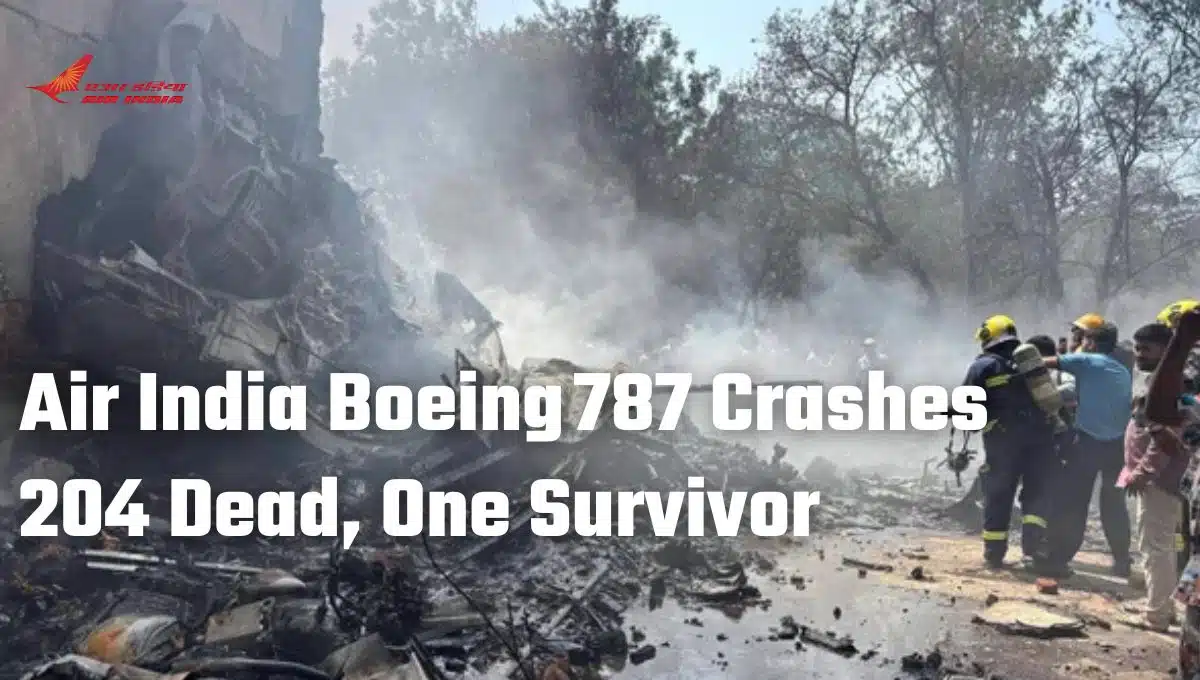On June 12, 2025, at 13:38 IST Air India Flight 171 a Boeing 787 8 Dreamliner registered VT ANB took off from Ahmedabad’s Sardar Vallabhbhai Patel International Airport heading for London Gatwick. Just 30 seconds later, the aircraft failed to rise, its engine stopped working, and it fell from about 400 feet, hitting a hostel building at B. J. Medical College on the Civil Hospital grounds. There was a big explosion and a fireball that made emergency teams rush in quickly.
The Human Toll and the Sole Survivor
There were 242 people on the plane including 230 passengers and 12 crew members. Tragically, 241 of them died along with more than 28 people on the ground. Nearly 60 others got injured. The only person who survived was British-Indian Vishwash Kumar Ramesh, who was in seat 11A by the emergency exit.
He survived the crash with small injuries and remained in a stable state. Eyewitnesses and authorities said it looked like a disaster zone, with crumbled buildings, dark smoke everywhere, and rescue teams battling extreme heat and fires fed by fuel.
Israel Makes Bold Move Striking Iran Killing Top Commanders And Hitting Nuclear Facilities
Early Theories Behind the Crash
Since the beginning, investigators have focused on some key details.
- Engine Thrust Loss: Experts believe both engines may have stopped working right after the plane took off, causing it to lose lift at a low altitude.
- Flap and Landing-Gear Configuration: The CCTV video seems to show that the landing gear was still down and the flaps weren’t in the right spot during take-off, which would cause a lot of drag and stop the plane from lifting properly.
- Maintenance or Human Error: The crew had plenty of flight hours behind them, but the aircraft was 11 years old. Authorities are now checking if something went wrong with maintenance, flap control, or engine power.
Investigators have mostly ruled out a bird strike since the video just shows dust clouds and no birds. Investigators are still checking if the fuel was contaminated or if someone tried to sabotage it, but those aren’t the top suspects.
Black Box Recovery and Global Expertise
On June 13, the authorities found the flight data recorder, which is a big step in figuring out what caused the crash. So far, they’ve recovered both the Flight Data Recorder and the Cockpit Voice Recorder. The Aircraft Accident Investigation Bureau is leading the investigation with help from the U.S. NTSB, FAA, UK’s AAIB, Boeing, and GE Aerospace.
Experts believe the black box could reveal some clues in a week, but the full report might take a year to complete. The DGCA in India has ordered urgent checks for every Air India Boeing 787 with GE GEnx engines, and there are more than 30 of them.
Political and Public Reactions
The response from top leaders was swift. Prime Minister Modi described the crash as “heartbreaking beyond words,” went to the site, saw the lone survivor, and offered support to the grieving families. Home Minister Amit Shah said the extreme heat made rescue work harder, confirmed that DNA tests were used to identify the bodies, and praised how quickly the agencies worked together.
Visited the crash site in Ahmedabad today. The scene of devastation is saddening. Met officials and teams working tirelessly in the aftermath. Our thoughts remain with those who lost their loved ones in this unimaginable tragedy. pic.twitter.com/R7PPGGo6Lj
— Narendra Modi (@narendramodi) June 13, 2025
Chaired a review meeting at Ahmedabad Airport with top authorities. pic.twitter.com/w2ADg9AqCB
— Narendra Modi (@narendramodi) June 13, 2025
Civil Aviation Minister Ram Mohan Naidu Kinjarapu said he is personally looking after the rescue work and the investigation. Congress President Mallikarjun Kharge and Opposition Leader Rahul Gandhi, along with others, said they were heartbroken and called for care and help for the families hit by the tragedy.
UK Prime Minister Keir Starmer, along with the Canadian and Portuguese Prime Ministers and other world leaders, offered their condolences. The UK organized help teams for British citizens in trouble, and major aviation bodies around the world offered their support.
Air India and Boeing’s Response
In only a few hours, Air India’s boss Natarajan Chandrasekaran and CEO Campbell Wilson spoke up with “deepest condolences,” arranged emergency help, offered ₹1 crore for every victim, and set up medical support handled by the Tata Group.
Boeing said it’s giving its full cooperation. It sent expert teams to Ahmedabad and put off plans like going to the Paris Airshow. Its stock futures dropped almost 5 to 9 percent after the crash. GE Aerospace also deployed engine expert teams to help with the analysis.
What Comes Next?
Short Term: Investigators are reviewing the flight data to check if the plane lost engine power, had wrongly set flaps, or kept its gear down. Special inspections are now underway for the fleet. Victim identification, DNA testing, family assistance, and memorial operations continue.
Medium to Long Term: A full report due in 12 months will likely suggest better safety steps for training, fixing planes, or how they’re made. The results could change how pilots handle flap and gear timing, adjust thrust, and do checks before take-off.
Significance in Aviation History
- It’s the first fatal accident and full loss of a Boeing 787 since it began flying in 2011.
- For Air India, this is the worst disaster since Flight 182 was bombed in 1985 and it’s the most severe in decades.
- A reminder that even planes less than ten years old still have risks if something goes wrong or if safety rules are ignored.
Final Thoughts
The Ahmedabad crash left India and the whole aviation world in shock. Experts are checking information from flight recorders and sensors, so clear answers might show up soon. But putting together the whole story with technical details, human reasons, and checks by officials will need more time.
The worldwide aviation community will stay tuned for the final AAIB report and hope these painful lessons lead to safer flights.



